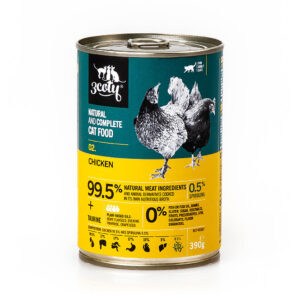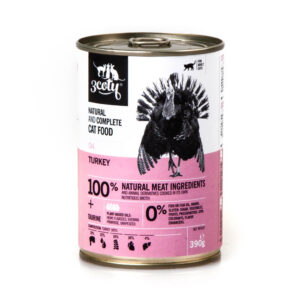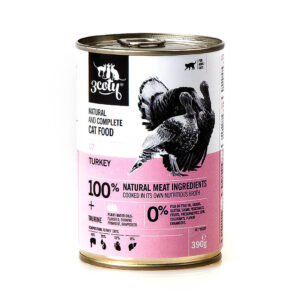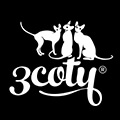In discussions with many cat owners on social media, it became clear that cat food labels are a difficult subject. All owners want to feed their cats the best possible food. Knowing what is best is not enough though. You also need to understand the label to make sure that the tin or bag or pouch actually contains what you want to feed your cat. There is a sea of information on both topics. We want to help you understand what makes good cat food and how to recognise that from the label. For our readers outside the EU, label requirements may be different! We know, for example, the US regulation of certain words is different to that of the EU. So far, the UK government has not changed its laws in this regard, so although outside the EU these days, the regulations for pet food labels remain the same.
We must realize that for cats to be healthy, they do not need speciality food but they do need quality food. But how can we tell how much of each is in the package we buy?
Some basic differences
Wet food versus dry food
First, we have to stress that wet food is better and healthier than dry food. Dry food should be avoided for cats, this is why:
– All wet foods contain a high amount of water which is crucial for cats’ urinary tract health.
– The protein in dry food is most frequently plant-based. Cats are obligate carnivores, they should eat food high in animal protein.
– Many dry foods contain a lot of carbohydrates which carnivores should avoid completely.
– There is a belief that dry food cleans cats’ teeth but there is very little evidence that it really helps. We would recommend using special cat teeth cleaning products instead.
Complete or Complementary?
Regardless of whether your cat food is dry or wet, the label will always indicate whether it is “A complete food for cats” or “A complementary food for cats”. Cat food must be labeled as either Complete or Complementary and of course, adding further features is permissible. For example, “complete food for adult cats” or “complementary food for obese cats” and there are lots of other additions for lots of circumstances, to aid urinary tract issues or diabetes or tailored to the cat’s age, for example for kittens or senior cats.
What does complete and complementary mean? Complete means that the pet food provides all the nutrients that your cat requires each day when fed as instructed on the label.
Complementary means that this cat food is intended to be mixed with something else so it is not a full meal. It could be a nutritional additive, a snack or a treat.
You should not give your cat exclusively complementary food. If only eating complementary foods, your cat will not get all the nutrients necessary for its well-being and over a long period, it could be dangerous to your cat’s health.
What some phrases on the label actually mean?
Universal language?
As we mentioned at the beginning – sometimes the detail depends on the country of origin of the food, as well as where it is intended to be sold. Products produced inside the European Union and intended for the EU market require to follow strict EU Regulations. Labels need to go through an approval process with the local authorities and depending on the country, these can be more or less flexible, but all are within the same limitations. We happen to produce our cat food in one of the strictest countries in the EU!
It is like climbing a ladder
Cat food should contain less than 10% carbohydrates, 40% or more protein and less than 50% fat. How do we find out whether the food is made in those proportions? In our view, one of the biggest problems with reading the labels is that manufacturers are not required to indicate the exact amount of what is used to make the cat food.
Often you also see terms like “with” or “rich in”, e.g. “with chicken” or “rich in turkey”. These phrases do give a hint of what proportion of the cat food is made up of the named ingredient:
– “flavoured with X” – less than 4% used. A cat food “flavoured with turkey” is over 96% NOT turkey!
– “with X” – at least 4%
– “rich in X” – at least 14%
– “X dinner” – at least 26%
So if you feed your cat with food that is rich in, let’s say, chicken then there is at least 14% of chicken meat in your cat food. Is that good or bad? We definitely would not want to feed our cats food that is only “rich in chicken” so only contains 14% chicken. No matter what the rest is, only 14% seems to be a bit too little in our view, keeping in mind that cats are true carnivores and should be on a 100% meat diet. Keep in mind, that these phrases apply to ALL the ingredients of the cat food. A label stating “with carrots” means at least 4% of food in the package is carrots.
Declaring ingredients by category or by single ingredient name
EU legislation permits disclosure of ingredient by category names defined in the legislation (e.g. meat and animal derivatives, vegetables, cereals, minerals) or by single ingredient names (e.g. dehydrated chicken protein, wheat, soybean meal, corn starch, chicken fat). The order is always from highest quantity to lowest.
Unfortunately, many manufacturers show as little information as possible about the ingredients of their cat foods. Some manufacturers only use very general terms, which should make consumers very suspicious about their products. In addition, some ingredients do not have to be listed at all, like preservatives.
“Increased” protein or “reduced” carbohydrates
Sometimes it might be beneficial for your cat’s diet to be slightly different from the “standard” range of products available. For example, a cat may benefit from a product with a higher level of protein than usual.
The manufacturer is allowed to make this clear by adding a statement such as “increased protein” on the packaging. This means that the protein content of this product is at least 15% higher than in a “standard” product. Similarly, “reduced”, means that the level of the named nutrient or ingredient is at least 15% lower than in a similar “standard” product.
“Standard” is defined not by the regulation, but by each manufacturer, therefore will vary from each manufacturer to another.
Grain-Free vs. Carb Free
Grain-free does not equal carbohydrate-free. Manufacturers often substitute potatoes, peas, and legumes for grains, but that does not reduce the carbohydrate content. Vegetable or fruit content should be minimal in cat food. To avoid using synthetic ingredients, some food producers include small amounts of fruits, vegetables, and herbs to ensure the necessary vitamin content. In this situation, the amount of fruit or vegetables should be so low that they appear far down the ingredient list.
Ingredient Splitting
On the topic of small amounts which appear low down on the ingredient list, there are instances of “splitting” filler ingredients to put them further down the list. Splitting “peas” into peas, pea flour, and pea protein means that rather than having to list peas as a major ingredient, the three items can be spread throughout the list of ingredients. If you see peas in the top 3-4 ingredients, and then pea protein and pea flour in the next few slots, the top ingredient could be peas. The same goes for potatoes. Definitely not appropriate for a carnivore.
“Human grade” cat food
Holistic, premium, super-premium, human-grade ingredients, veterinarian recommended.
There are some strict regulations regarding some words in some countries. Depending on where the manufacturer is under the supervision of veterinary authorities, they may be restricted from using some terms. In the EU specifically, the terms “natural” and “organic” do have defined meanings…
Natural
Terms “Natural food” or “all-natural food” describes food that is not-ultra-processed, where ingredients are natural products (i.e. substances produced by living organisms, also found in nature). You can read more about natural food in our blog post – Natural cat feeding.
Organic
The emergence of organic products has been at different speeds in different countries and often started as a voluntary movement. For example, the UK the Soil Association awards organic status to products, in Germany (where the term is Bio) three associations award the Bio-Zertifikat, in Ireland, there are two certification bodies. There is an EU-wide scheme which all these different country regulations comply with, however, you may see the country-specific terminology too. One of the requirements to gain the EU certificate for a final product is that at least 95% of the final product, from start to finish, needs to be certified. From the field in which the grain grows which the chickens eat which end up in the tin of cat food. If a product has some organic ingredients, but the total is less than 70% the producer can show the organic ingredients in the ingredient panel but cannot label the product organic. To gain the EU organic product certificate (bio in some languages) a manufacturer needs to know exactly where every single one of their ingredients come from, how each is grown, managed and harvested/slaughtered.
How meat ingredient categories are defined
We know that many cat owners are reading food labels because they want the best for their cats, but do not understand some of the words on the labels. An obvious place to ask is friends on social media, however, the regulation on this varies around the world. To properly understand the terminology on the label, you need to know where and for whom it was written and why it is written that way before being able to advise others. We are based in the EU and sell mainly in the EU so use all the EU definitions. The Australian or US ones may also be in English, but may not mean the same thing.
Meat
Meat is defined as “the clean flesh derived from slaughtered mammals and limited to that part of the striated muscle which is skeletal or that part which is found in the tongue, in the diaphragm, in the heart or in the oesophagus; with or without the accompanying and overlying fat and portions of the skin, sinew, nerve and blood vessels which normally accompany the flesh.”
In other words, meat is primarily the muscle tissue of the animal but may include fat, gristle and other tissues normally accompanying the muscle, similar to what is sometimes seen in raw meat sold for human consumption.
Under the EU regulation, the term “human-grade meat” so much wanted by cat owners, is not the approved term to be used on the packaging for cat food. Even if the meat was “human grade” we would not be allowed to say that on food sold for cats. So it is important to check the detailed description on the label.
Animal derivatives
Animal derivatives is the term used for parts of an animal that are surplus from the human food chain. This might include some muscle meat, as well as materials like the lungs, kidneys, hearts and livers but, of course, only comes from animals that have been passed fit for human consumption.
Meat by-products
Confusingly, in the US, this refers to the animal parts called Animal derivatives in the EU. In the EU however, it relates to the parts which are not used for human consumption, such as hooves, tails, skin.
Rendered Products
These have been cooked to destroy any harmful bacteria before they are shipped to a pet food manufacturing plant. During rendering, heat and pressure remove most of the water and fat, leaving primarily protein and minerals.
Meat/Poultry/Bone Meal
There are “meal” versions of all of the above. In the first instance, the word “meal” indicates that in addition to having been cooked, the products will have been ground to form uniform-sized particles. There are regulations about the calcium and other mineral ingredients to ensure that cooking and grinding has not resulted in an over-concentration of these ingredients. In laypersons terms, this type of food has been processed to the maximum.
As cats tend to eat a whole animal in the wild, their natural diet will include liver, lungs and kidneys. Therefore don’t be concerned if the term “meat by-products” appears on the label of the tin of cat food in your cupboard. It likely means the content of the tin more closely resembles your cat’s natural diet than if it only ate muscle meat like chicken breast.
Non-meat ingredients
Preservatives
Preservatives can either be manufactured or natural. Vitamin E (mixed tocopherols) and C (ascorbic acid) are natural preservatives used to prevent the fat in foods from going rancid. Rosemary is another natural extract included in many foods as a preservative. Ethoxyquin, BHA and BHT are typical man-made preservatives, rarely used in higher quality foods. Other preservatives include benzoic acid, calcium ascorbate, citric acid, ethoxyquin, potassium sorbate and sodium bisulphite. Producers of cat food do not have to disclose any of them on the packaging of pet food. Only because they are not on the label, does not mean they are not in the tin!
Carbohydrates
You can get a rough estimate of the carbohydrate value in food by subtracting the moisture, protein, fat, fibre, and ash/mineral content if given, from 100. Most dry food contains around 8% ash/minerals and most canned food has 2.5 to 3%. If the manufacturer does not disclose the ash or mineral content, use those values to estimate the carbohydrate amount. What remains will give you a starting point on carbohydrate level. Note, that when comparing different brands, the moisture element also plays a role, see “Moisture makes a difference” to confidently compare between wet and dry foods or different brands.
Other Common Ingredients
Animal fat and vegetable fat or oil are commonly used to supply additional nutrients and flavour to pet food. Plant ingredients, such as corn, barley, peas and potatoes, also supply calories and nutrients and help dry food hold together. Dried beet pulp, dried chicory root, fructooligosaccharide, powdered cellulose and inulin, among other select ingredients, often offer dietary fibre. There are also often conditioning agents, thickeners, emulsifiers, sequestrants, flavours and seasonings such as carrageenan, propylene glycol (in dog food only, propylene glycol is unsafe for cats and is prohibited from use in cat food), sodium hexametaphosphate, agar-agar, guar gum, common spices and extracts, such as ginger, chamomile, fennel and so on. Apart from the propylene glycol, the presence of these will not cause harm, however, they do chip away at the total amount of protein and fat a cat should be consuming.
What else?
Minerals, Vitamins and Amino Acids – this is a material for another long article. The most important is Taurine. Information about added Taurine has to be present on the label. We devoted a whole article to Taurine recently where we explain why it is important for cats: Taurine – what is it and why it is essential for your cat?
Moisture makes a difference
It can be difficult to compare the protein, fat and carbohydrate levels between different foods by using the information on a package’s label. This is especially difficult when comparing pet foods with large differences in moisture (tinned or pouches vs. dry) or fibre level. Tinned foods or pouches can have up to 80% moisture, whereas some dry foods can have as little as 6%. The quantities listed on the label are for the food as it is fed, not as it would be on a dry matter basis. To make a more balanced comparison, you need to convert the as-fed basis to a dry-matter basis.
Converting to a Dry Matter Basis
Calculating the content of an ingredient or component on a dry-matter basis is quite simple.
If a dry pet food has 10% moisture, then it must have 90% dry matter. If a label shows that dry food has a protein level of 20% on an as-fed basis, then to calculate the dry-matter basis, divide the 20% protein by the 90% dry matter and then multiply by 100 to convert it into percentage terms. In this example, 20/90 is 0.22, which multiplied by 100 equals 22%. So the example food has 22% protein on a dry-matter basis. Does this make sense so far? Good.
In order to compare the protein content in this dry food to that of a wet food, the protein content of the other diet must also be converted to a dry-matter basis. If a tin of food has 80% moisture, it will have 20% dry matter. If the label shows a 5% protein content on an as-fed basis, take the 5% and divide it by 20% dry matter x100, to get 25% protein on a dry matter basis. Therefore, in this example, the tinned food has more protein per kilo on a dry-matter basis after all the water is taken out. The same calculation can also be used to compare the fat,
carbohydrates and fibre contents in diets.

Beyond the Cat Food Labels
There are many other questions to ask when selecting a food but deciphering cat food labels is a good starting point. Don’t stop with the labels on the cans. Often a manufacturer will give more information about their products on their website or promotional information in the store. You can also contact them and ask.
Remember also that label regulations are evolving and changing.
If your cat does not need it, you will not find it in 3coty® cat food
At 3coty® we like simplicity, but not shortcuts. A cat’s natural diet is simple and based on meat. After all, cats are true carnivores and a proper diet affects their quality of life and longevity.
We have created the system of symbols we use on all our packaging, to help you understand and read the contents of our food.
We live by our rules and do not use ingredients in our products that could cause allergies or simply are not needed in cat’s diet. After all, a properly fed cat is a happy cat.
If you want more information on our food, we are here to answer or help. Reach out to us via email or via chat-functionality on our website.









